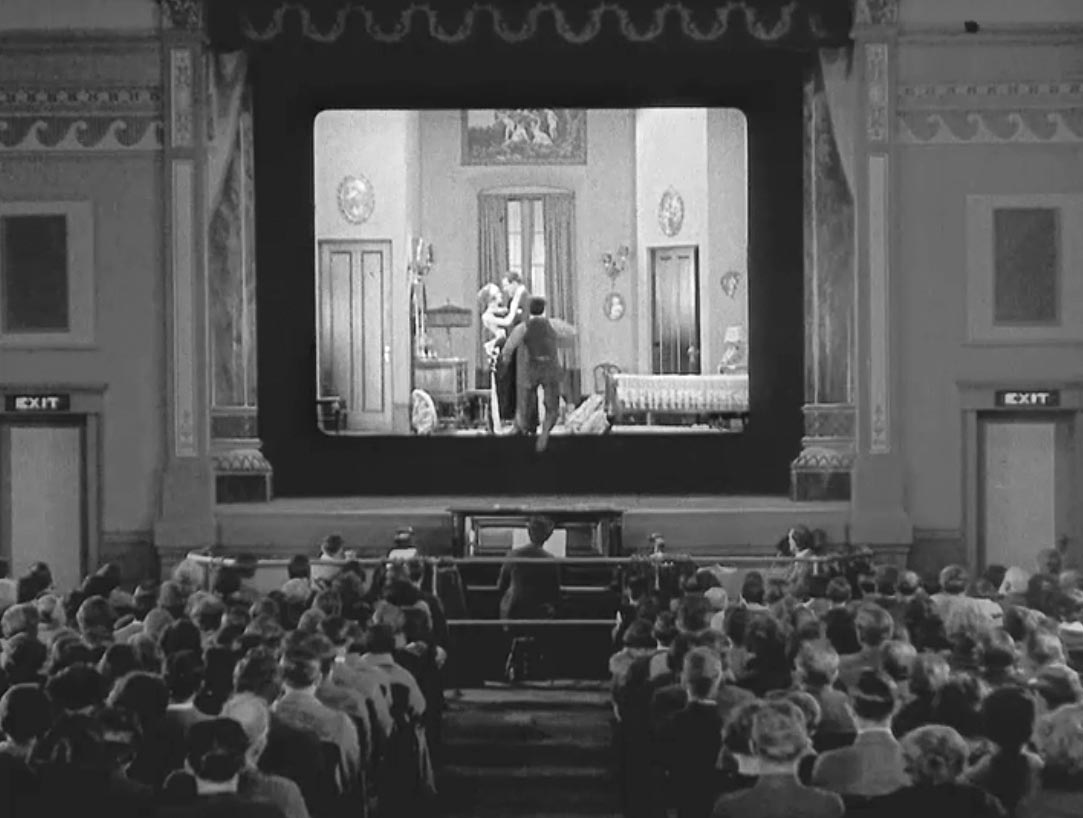My Life Filtered Through the Silver Screen
An idea I find personally resonant about people and the movies – expressed by cineastes as varied as Francois Truffaut, Jan Troell, Krzysztof Kieslowski, and Michael Powell – is that a certain personality finds it much easier to recognize emotions and ideas on the big screen than in real life. How such personalities fared before the advent of cinema I do not pretend to know – maybe they had very rich dream lives – but experiencing reality at a distance, as a recorded medium to be viewed and re-viewed, seems to me a very uniquely twentieth century “condition”. Let’s call it, for the sake of convenience, the plight of the cinemaddict.
The condition may strike at an early age, as it partially did for me, or make its insidious influence increasingly apparent as the sufferer – the inveterate voyeur – ages. For a particularly pathological cinemaddict – as I may or may not claim to be – one’s friendships, family relations, career options, and even one’s day-to-day experience of life itself may wither away before the all-consuming passion of watching movies, experiencing movies, and thinking about movies. Indeed, one may one day simply forgo the cares and vicissitudes of this workaday world, slipping Alice Through the Looking Glass – or, more appropriately, Buster Through the Silver Screen – into pure cinemapsychosis.
Though this discussion may be somewhat tongue-in-cheek, my love of movies, I feel, is entirely genuine. So, if the dangers of the cinemaddict lie in the possibility of living exclusively through movies, well, then, so be it: for, as Cinematheque Francais founder Henri Langlois once observed, “to love cinema is to love life, to really look at this window on the universe.” Yes, my own boundaries may be a little blurred between reality and the movies, with favor skewed heavily toward the latter, but I feel all the more enriched for it.
Which, I suppose, is why I suggested this exercise. Not only for the discussions and inherent interest such a topic might engender, but that for the true cinemaddict coming up with a “top ten” list would be ultimately like describing one’s own unique qualities as a person. Pleasantly afflicted with varying degrees of cinemaddiction, those who – for whatever reasons – find their lives wrapped up in movies, and for whom a love of one is mutually inclusive with a love of the other, might discover something about their own identity, their own unique window on the universe, by really grappling with and positively identifying their own “favorite films of all time”.
For better or worse, then, here’s a brief rundown of those films that are, for me, given the number of times I’ve returned for a movie-fix on each one of these titles, most cinamaddict:
10. Naked
(1993, Channel 4 Productions, dir. Mike Leigh)
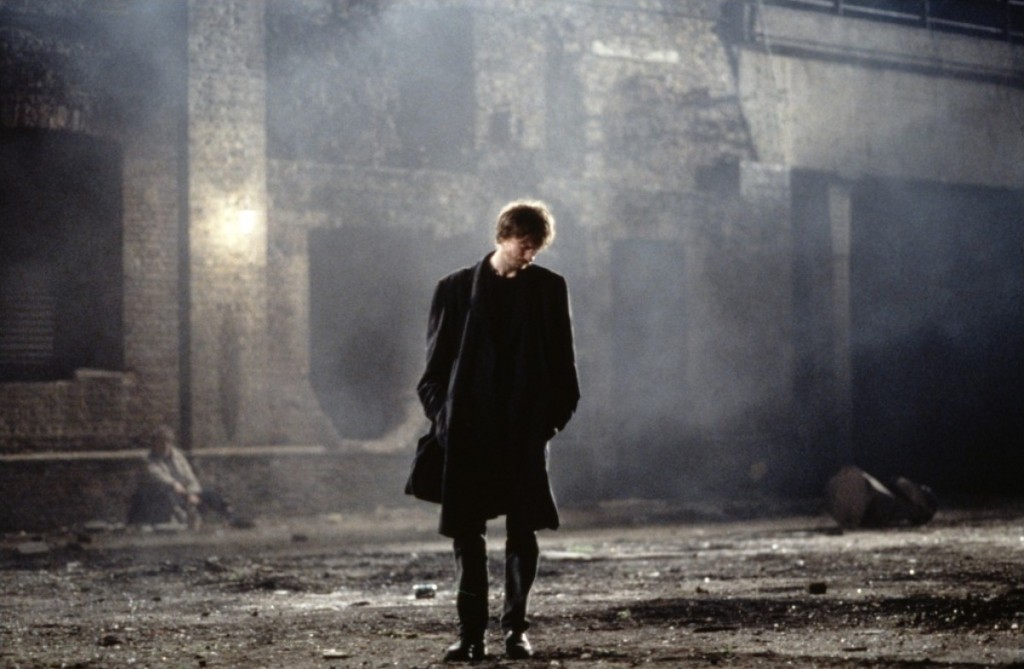 Mike Leigh’s Naked is a movie I have really (really) grappled with, most often unsuccessfully, since I first saw it, a few years after high school, on VHS. Why am I drawn to this movie? Centering around an almost willfully unpleasant, misanthropic, masochistic, verbally (and physically) abusive near-drifter and his pointless, dangerous, self-destructive nighttime descent into an almost post-urban hellscape – along with the equally sad, lonely, pathetic figures he encounters along the way – Naked hasn’t exactly won many “audience favorite” awards. It has, however, retained every bit of its power and impact, and actually seems to gain in relevancy through the passing of the years as more and more “lost” individuals surrender themselves to the insoluble uncertainties of the early twenty-first century. In one of the greatest screen performances (period), David Thewlis as Johnny takes the film to places that possibly even director Leigh, famous for his improvisatory working methods, had not intended to go, but for 131 minutes holds – nay, commands – an audience’s rapt attention. As with the night watchman (Peter Wight) before whom Johnny holds accusatory court in a shadowy “post-modern gas chamber” (actually, a stylish central London office building way after-hours), our own spellbound reaction to the character is not easily explained, but compels the inherent fascination offered by other inky-black figures – such as a Hamlet or Macbeth – who stand outside the pleasant, easily-digested scheme of things. Like a dark mirror held to one’s midnight soul, Johnny and Naked remind this viewer, at least, of aspects of himself that he might otherwise prefer to forget.
Mike Leigh’s Naked is a movie I have really (really) grappled with, most often unsuccessfully, since I first saw it, a few years after high school, on VHS. Why am I drawn to this movie? Centering around an almost willfully unpleasant, misanthropic, masochistic, verbally (and physically) abusive near-drifter and his pointless, dangerous, self-destructive nighttime descent into an almost post-urban hellscape – along with the equally sad, lonely, pathetic figures he encounters along the way – Naked hasn’t exactly won many “audience favorite” awards. It has, however, retained every bit of its power and impact, and actually seems to gain in relevancy through the passing of the years as more and more “lost” individuals surrender themselves to the insoluble uncertainties of the early twenty-first century. In one of the greatest screen performances (period), David Thewlis as Johnny takes the film to places that possibly even director Leigh, famous for his improvisatory working methods, had not intended to go, but for 131 minutes holds – nay, commands – an audience’s rapt attention. As with the night watchman (Peter Wight) before whom Johnny holds accusatory court in a shadowy “post-modern gas chamber” (actually, a stylish central London office building way after-hours), our own spellbound reaction to the character is not easily explained, but compels the inherent fascination offered by other inky-black figures – such as a Hamlet or Macbeth – who stand outside the pleasant, easily-digested scheme of things. Like a dark mirror held to one’s midnight soul, Johnny and Naked remind this viewer, at least, of aspects of himself that he might otherwise prefer to forget.
9. The Draughtsman’s Contract
(1982, British Film Institute, dir. Peter Greenaway)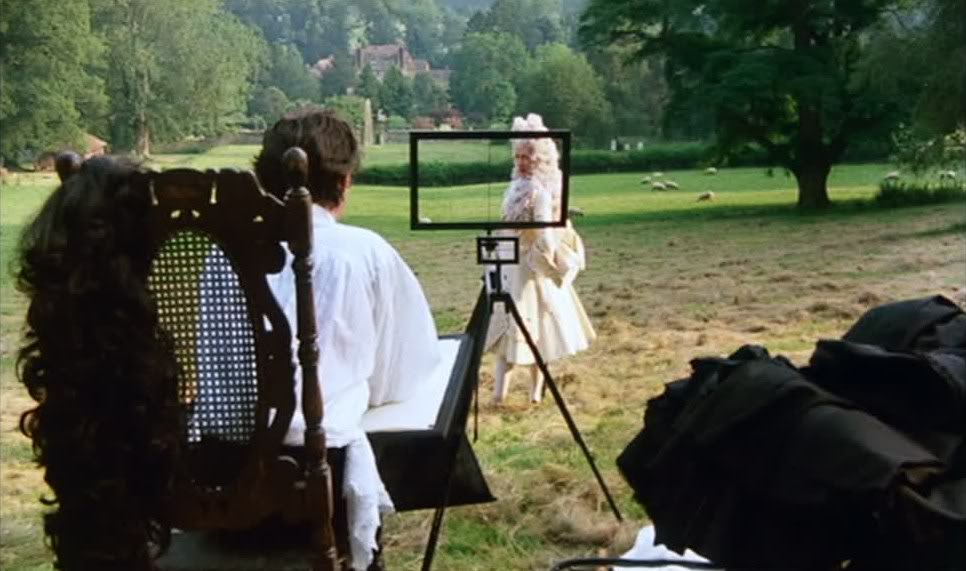 I first saw The Draughtsman’s Contract during a class on Restoration-era British literature and, after having watched many (many) period pieces, both before and after, have yet to encounter a historical movie that so successfully embodies its specific historical era. Stately, witty, and cruel, The Draughtman’s Contract makes British country life in the late 17th century – 1694, to be exact – come alive with the startling immediacy of a devastatingly satirical page from Joseph Addison’s The Spectator or a ribald rejoinder from a racy John Dryden comedy. Mr. Neville, a “talented young draughtsman” (Anthony Higgins), agrees to make 12 separate drawings of the estate of Mrs. Herbert (Janet Suzman) in exchange for the “unrestricted freedom of her most intimate hospitality.” Matters artistic, domestic, and – yes – sexual proceed apace and soon Mr. Neville has entered on a similar agreement – to his ultimate disfavor – with the daughter of the estate, Mrs. Tallman (Anne-Louise Lambert), while oddly mounting visual clues accumulate daily in Mr. Neville’s black-and-white drawings concerning “misadventure” and the fate of the curiously absent estate owner, Mr. Herbert (Dave Hill). Part murder mystery and part Masterpiece Theatre-style costume drama – along with some of the most ravishing images, music, and wordplay you’ll encounter in a film – The Draughtsman’s Contract is one of the few movies set in another time and place that actually looks, sounds, and feels as if it was made in the historical period it is depicting.
I first saw The Draughtsman’s Contract during a class on Restoration-era British literature and, after having watched many (many) period pieces, both before and after, have yet to encounter a historical movie that so successfully embodies its specific historical era. Stately, witty, and cruel, The Draughtman’s Contract makes British country life in the late 17th century – 1694, to be exact – come alive with the startling immediacy of a devastatingly satirical page from Joseph Addison’s The Spectator or a ribald rejoinder from a racy John Dryden comedy. Mr. Neville, a “talented young draughtsman” (Anthony Higgins), agrees to make 12 separate drawings of the estate of Mrs. Herbert (Janet Suzman) in exchange for the “unrestricted freedom of her most intimate hospitality.” Matters artistic, domestic, and – yes – sexual proceed apace and soon Mr. Neville has entered on a similar agreement – to his ultimate disfavor – with the daughter of the estate, Mrs. Tallman (Anne-Louise Lambert), while oddly mounting visual clues accumulate daily in Mr. Neville’s black-and-white drawings concerning “misadventure” and the fate of the curiously absent estate owner, Mr. Herbert (Dave Hill). Part murder mystery and part Masterpiece Theatre-style costume drama – along with some of the most ravishing images, music, and wordplay you’ll encounter in a film – The Draughtsman’s Contract is one of the few movies set in another time and place that actually looks, sounds, and feels as if it was made in the historical period it is depicting.
8. Shadow of a Doubt
(1943, Universal Pictures, dir. Alfred Hitchcock)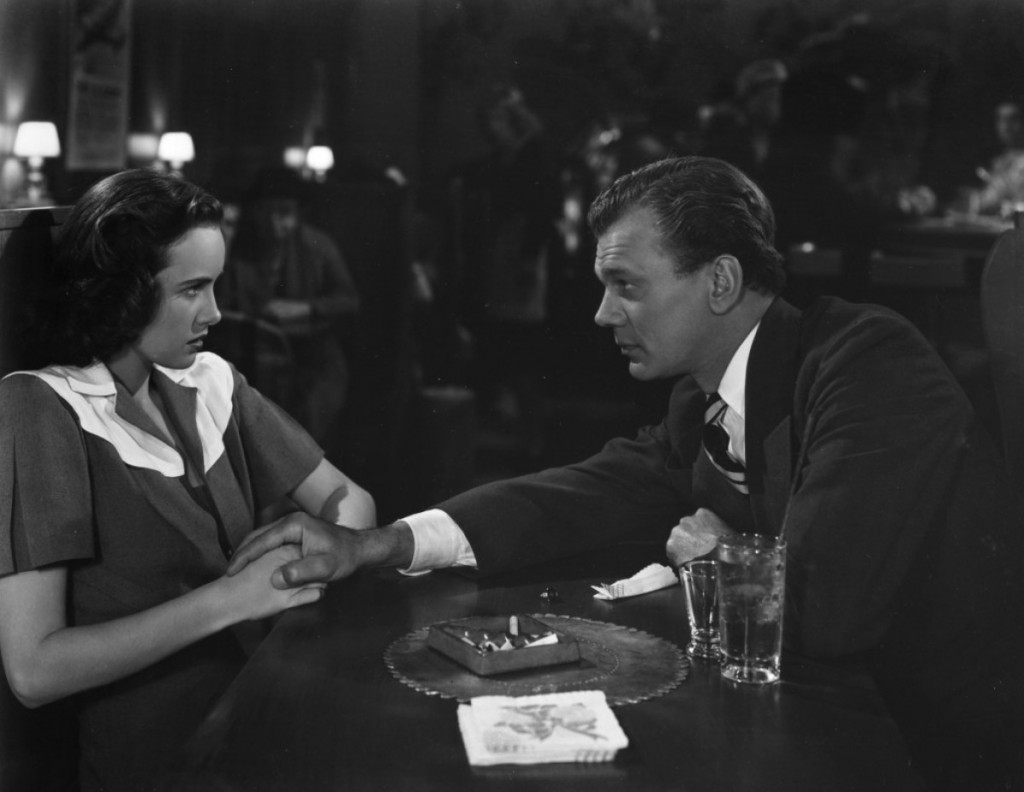 In an oeuvre with no shortage of masterpieces, no self-respecting top ten list is complete without at least one nod to the master of suspense, Alfred Hitchcock. From the sheer technical perfection of Psycho (1960) to the dizzyingly dreamlike atmosphere of Vertigo (1958), or the gripping romantic betrayals of Notorious (1946) to the cornerstone of the entire spy genre, North by Northwest (1959), a true cine-maladist would be hard-pressed to single out the one Hitchcock picture that stands above the rest. So I’m not even going to try. Rather, I’ll simply pick my favorite: Shadow of a Doubt. For one thing, it was Hitchcock’s personal favorite among his 54 films and, for another, the terror and dread Hitchcock mines in this, his most subversively terrifying and dreadful thriller, sits cozily reading newspapers and comfortably smoking cigars at his collective viewer’s family dinner table. Niece Charlie (Teresa Wright) seems to share an almost “twin-like” bond with magical Uncle Charlie (Joseph Cotten), for whom she is named, and has all her wishes come true when her favorite relative pays her family a visit in the idyllic smalltown of Santa Rosa, California. Sharing such a close bond with her uncle, though, young Charlie soon realizes that there’s more to her relative’s visit than mere familial pleasantry and, through intuitions bordering on the preternatural, begins to link the genial, courtly near-relation with coast-to-coast reports of the “Merry Widow Killer”. Hitchcock collaborated with Our Town playwright Thornton Wilder to remove the more exotic elements from previous thrillers – such as The Lady Vanishes (1938) or Foreign Correspondent (1940) – in order to truly bring the horror “home” for his viewers.
In an oeuvre with no shortage of masterpieces, no self-respecting top ten list is complete without at least one nod to the master of suspense, Alfred Hitchcock. From the sheer technical perfection of Psycho (1960) to the dizzyingly dreamlike atmosphere of Vertigo (1958), or the gripping romantic betrayals of Notorious (1946) to the cornerstone of the entire spy genre, North by Northwest (1959), a true cine-maladist would be hard-pressed to single out the one Hitchcock picture that stands above the rest. So I’m not even going to try. Rather, I’ll simply pick my favorite: Shadow of a Doubt. For one thing, it was Hitchcock’s personal favorite among his 54 films and, for another, the terror and dread Hitchcock mines in this, his most subversively terrifying and dreadful thriller, sits cozily reading newspapers and comfortably smoking cigars at his collective viewer’s family dinner table. Niece Charlie (Teresa Wright) seems to share an almost “twin-like” bond with magical Uncle Charlie (Joseph Cotten), for whom she is named, and has all her wishes come true when her favorite relative pays her family a visit in the idyllic smalltown of Santa Rosa, California. Sharing such a close bond with her uncle, though, young Charlie soon realizes that there’s more to her relative’s visit than mere familial pleasantry and, through intuitions bordering on the preternatural, begins to link the genial, courtly near-relation with coast-to-coast reports of the “Merry Widow Killer”. Hitchcock collaborated with Our Town playwright Thornton Wilder to remove the more exotic elements from previous thrillers – such as The Lady Vanishes (1938) or Foreign Correspondent (1940) – in order to truly bring the horror “home” for his viewers.
7. Chinatown
(1974, Paramount Pictures, dir. Roman Polanski)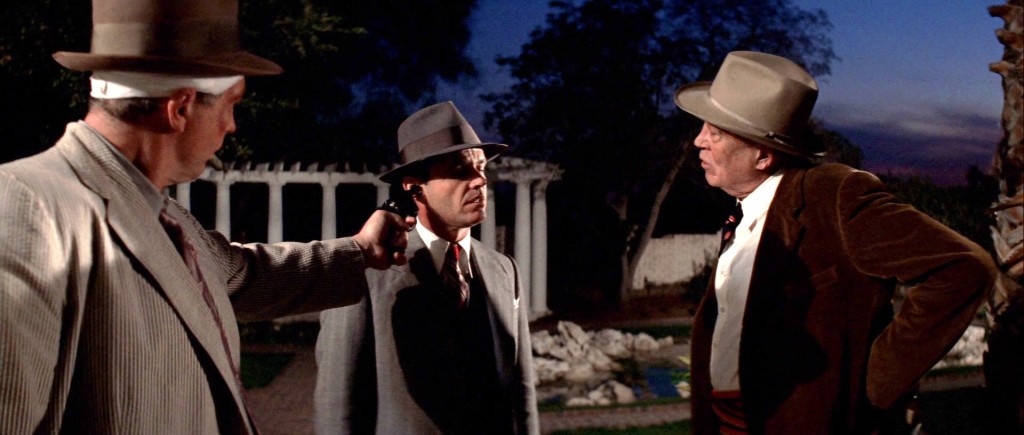 Nighttime. A puff of smoke emerges from under the shadowy arch of a hacienda-style Southern California mansion, followed by a dapper-dressed dude sauntering smoothly into the frame. From the opposite side of the frame, an enfeebled old man – genial, courtly, elegant – struggles on a cane towards the stylish gent, trailed by a hulking bodyguard packing heavy heat, and intones in deep, velvety tones, “Where’s the girl?” If I had to pick my favorite genre of Hollywood filmmaking, that genre would undoubtedly be the great films noir of the 1940s and 50s. Set in Los Angeles in 1936, Chinatown is about the making (or un-making, depending on your point of view) of a city, told in a style that simultaneously evokes and departs from the style and storytelling conventions of traditional film noir. Made by a foreign director with a distinctly European arthouse sensibility (Roman Polanski), shot in blazing color in an at times almost cinema verite-style (John A. Alonzo), flawlessly written with an almost implicitly Marxist criticism of real history (Robert Towne), and starring the very embodiment of 1970s New Hollywood Cinema (Jack Nicholson), Chinatown is one moment in Hollywood history where realization of its vision exactly matched – and possibly exceeded – its ambition. With the lean, stripped-to-the-sinews dialogue characteristic of the genre – along with the added weight of 38 years of insidiously long-lasted “respectability” plastered across road signs, town names, and office buildings – L.A. “P.I. to the Stars” J.J. Gittes (Nicholson), casually flicking a long, cylindrical flame of ash from between his fingers, pointedly responds to the question posed above by the most powerful man in Los Angeles (John Huston as Noah Cross; a stand-in for the real-life William Mulholland) with devastating aplomb: “She’s with her mother.”
Nighttime. A puff of smoke emerges from under the shadowy arch of a hacienda-style Southern California mansion, followed by a dapper-dressed dude sauntering smoothly into the frame. From the opposite side of the frame, an enfeebled old man – genial, courtly, elegant – struggles on a cane towards the stylish gent, trailed by a hulking bodyguard packing heavy heat, and intones in deep, velvety tones, “Where’s the girl?” If I had to pick my favorite genre of Hollywood filmmaking, that genre would undoubtedly be the great films noir of the 1940s and 50s. Set in Los Angeles in 1936, Chinatown is about the making (or un-making, depending on your point of view) of a city, told in a style that simultaneously evokes and departs from the style and storytelling conventions of traditional film noir. Made by a foreign director with a distinctly European arthouse sensibility (Roman Polanski), shot in blazing color in an at times almost cinema verite-style (John A. Alonzo), flawlessly written with an almost implicitly Marxist criticism of real history (Robert Towne), and starring the very embodiment of 1970s New Hollywood Cinema (Jack Nicholson), Chinatown is one moment in Hollywood history where realization of its vision exactly matched – and possibly exceeded – its ambition. With the lean, stripped-to-the-sinews dialogue characteristic of the genre – along with the added weight of 38 years of insidiously long-lasted “respectability” plastered across road signs, town names, and office buildings – L.A. “P.I. to the Stars” J.J. Gittes (Nicholson), casually flicking a long, cylindrical flame of ash from between his fingers, pointedly responds to the question posed above by the most powerful man in Los Angeles (John Huston as Noah Cross; a stand-in for the real-life William Mulholland) with devastating aplomb: “She’s with her mother.”
6. Jules and Jim
(1962, Les Films du Carosse, dir. Francois Truffaut)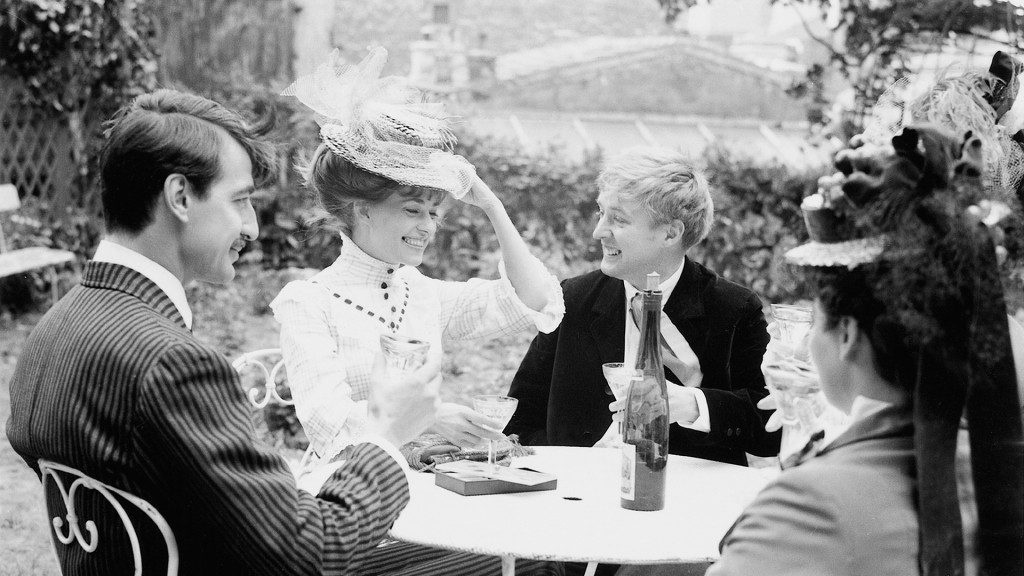 One thing I have yet to mention in these obligatory mini-reviews is music and, more particularly, film scoring. Referring to one of my earlier selections, The Draughtsman’s Contract, without Michael Nyman’s lush rendering of themes from English Baroque composer Henry Purcell (1659 – 1695) – given fanciful titles from the film’s dialogue like “Chasing Sheep is Best Left to Shepherds” and “An Eye for Optical Theory” – director Peter Greenaway’s static, though exquisitely composed, images might very well fall flat, rendering the audience quite literally insensible in absence of their perfect aural complement. Such, I feel, is precisely the case with my next selection, Jules and Jim; which, if I have to admit to it, I’ve probably seen more times than any film on this list, watching it on average 3-4 times per year since I first borrowed – and then often re-borrowed – a VHS copy from Monona Library in 1997. (Having since viewed it on various progressively-better formats, crowned presently by my personal DVD/Blu-ray released by Criterion in 2014, means that by this point I’ve seen the film about 76 times.) A key work of the French New Wave – and, for Jules and Jim‘s director, Francois Truffaut, possibly his masterpiece – what truly draws me in to this story of a three-cornered romance in the early years of the twentieth century is indeed composer Georges Delerue’s lovely, haunting, evocative score. As those weak adjectives proceeding the word “score” unfortunately attest, writing about music is like “dancing about architecture” (quoting comedian Martin Mull), but, as the almost-palpable sense of melancholy equally attests in Delerue’s wistful musical theme “dangerous love” (so dubbed by film scholars David Bordwell and Kristin Thompson in their indispensable textbook Film Art), the power of music to evoke memory and time finds its perfect complement in cinema.
One thing I have yet to mention in these obligatory mini-reviews is music and, more particularly, film scoring. Referring to one of my earlier selections, The Draughtsman’s Contract, without Michael Nyman’s lush rendering of themes from English Baroque composer Henry Purcell (1659 – 1695) – given fanciful titles from the film’s dialogue like “Chasing Sheep is Best Left to Shepherds” and “An Eye for Optical Theory” – director Peter Greenaway’s static, though exquisitely composed, images might very well fall flat, rendering the audience quite literally insensible in absence of their perfect aural complement. Such, I feel, is precisely the case with my next selection, Jules and Jim; which, if I have to admit to it, I’ve probably seen more times than any film on this list, watching it on average 3-4 times per year since I first borrowed – and then often re-borrowed – a VHS copy from Monona Library in 1997. (Having since viewed it on various progressively-better formats, crowned presently by my personal DVD/Blu-ray released by Criterion in 2014, means that by this point I’ve seen the film about 76 times.) A key work of the French New Wave – and, for Jules and Jim‘s director, Francois Truffaut, possibly his masterpiece – what truly draws me in to this story of a three-cornered romance in the early years of the twentieth century is indeed composer Georges Delerue’s lovely, haunting, evocative score. As those weak adjectives proceeding the word “score” unfortunately attest, writing about music is like “dancing about architecture” (quoting comedian Martin Mull), but, as the almost-palpable sense of melancholy equally attests in Delerue’s wistful musical theme “dangerous love” (so dubbed by film scholars David Bordwell and Kristin Thompson in their indispensable textbook Film Art), the power of music to evoke memory and time finds its perfect complement in cinema.
5. The Adventures of Robin Hood
(1938, Warner Brothers, dir. Michael Curtiz w/ William Keighley)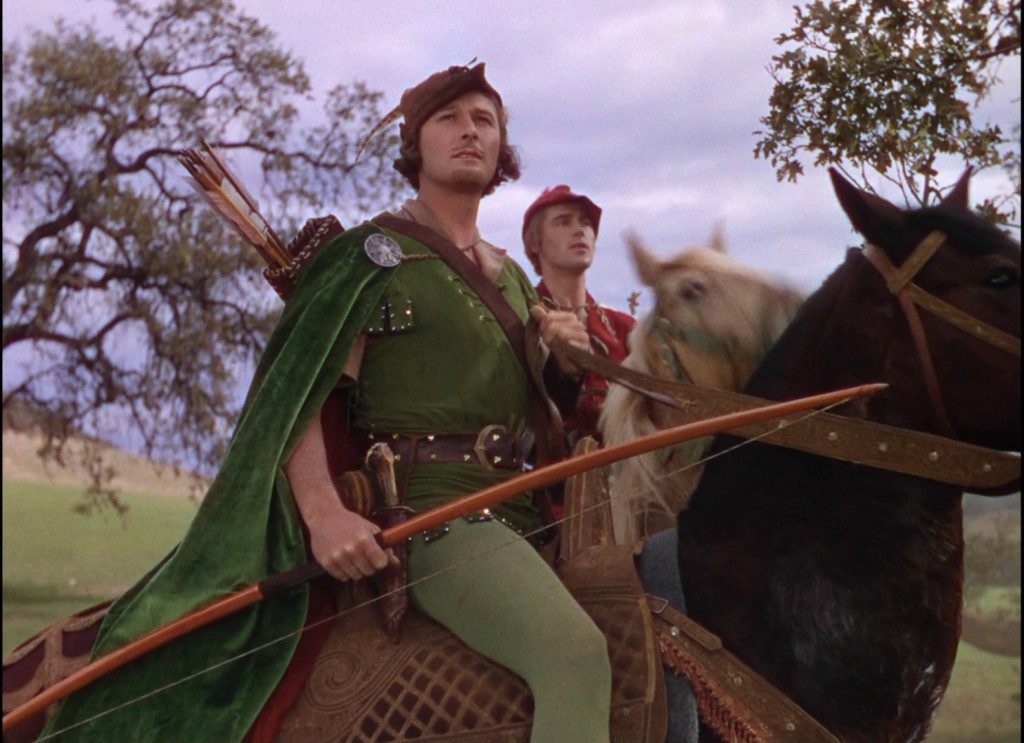 As we move towards the latter half of my list, something that strikes me is that while I saw my first five selections well after high school, these next four selections have been with me much, much longer. Since childhood, in fact. And, appropriately, there’s no movie that makes me feel more like a kid than Warner Brothers’ sterling 1938 Technicolor production of The Adventures of Robin Hood. Starring the lustiest man to ever be photographed wearing green tights, the great Errol Flynn, this movie is like every Sunday after church I spent on the green shag rug of my parents’ living room reading comic books, “Classics Illustrated” adventure stories, and Hardy Boys mysteries. “Swashbuckler” simply doesn’t do the film justice, as The Adventures of Robin Hood sets out to tell the story of the fabled English outlaw, along with his Merry Men in the wilds of Sherwood Forest, and, after 700 years of ballads and legends, Hollywood here gives the oft-told tales their best possible realization. As per our discussion above, composer Erich Wolfgang Korngold sets the tone perfectly with his blaring horns-tinged score, and every performance, from hissable screen villains Claude Rains (as Prince John) and Basil Rathbone (as Sir Guy of Gisbourne) to staunch breeches and sackcloth-clad allies Alan Hale (as Little John) and Eugene Pallette (as Friar Tuck), is brought to vivid life by the painterly tones of Technicolor and the artful compositions and expert action pacing of resident Warner Brothers genius Michael Curtiz. For some, the height of Classic Hollywood studio filmmaking may be The Wizard of Oz (1939), for others it might be Gone with the Wind (1939) – for still others it might be Casablanca (1942) or Citizen Kane (1941) – but, for me, it will always be my childhood favorite, The Adventures of Robin Hood.
As we move towards the latter half of my list, something that strikes me is that while I saw my first five selections well after high school, these next four selections have been with me much, much longer. Since childhood, in fact. And, appropriately, there’s no movie that makes me feel more like a kid than Warner Brothers’ sterling 1938 Technicolor production of The Adventures of Robin Hood. Starring the lustiest man to ever be photographed wearing green tights, the great Errol Flynn, this movie is like every Sunday after church I spent on the green shag rug of my parents’ living room reading comic books, “Classics Illustrated” adventure stories, and Hardy Boys mysteries. “Swashbuckler” simply doesn’t do the film justice, as The Adventures of Robin Hood sets out to tell the story of the fabled English outlaw, along with his Merry Men in the wilds of Sherwood Forest, and, after 700 years of ballads and legends, Hollywood here gives the oft-told tales their best possible realization. As per our discussion above, composer Erich Wolfgang Korngold sets the tone perfectly with his blaring horns-tinged score, and every performance, from hissable screen villains Claude Rains (as Prince John) and Basil Rathbone (as Sir Guy of Gisbourne) to staunch breeches and sackcloth-clad allies Alan Hale (as Little John) and Eugene Pallette (as Friar Tuck), is brought to vivid life by the painterly tones of Technicolor and the artful compositions and expert action pacing of resident Warner Brothers genius Michael Curtiz. For some, the height of Classic Hollywood studio filmmaking may be The Wizard of Oz (1939), for others it might be Gone with the Wind (1939) – for still others it might be Casablanca (1942) or Citizen Kane (1941) – but, for me, it will always be my childhood favorite, The Adventures of Robin Hood.
4. Young Frankenstein
(1974, 20th Century Fox, dir. Mel Brooks)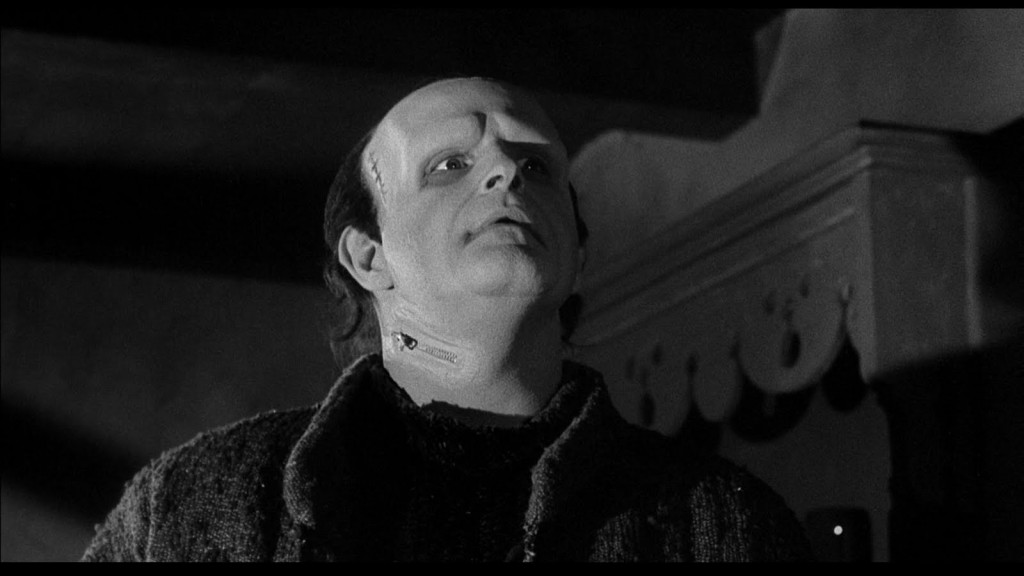 When I first saw Young Frankenstein on Public Television at the tender age of 8 ½ I was actually unaware that it was a comedy. Seriously. “What knockers!”, “schwanzstucker”, and a lumbering monster doing a soft-shoe routine to “Puttin’ on the Ritz” completely flew over my head and I flipped the dial on our circa 1970 tinfoil-encrusted-on-rabbit ears TV set entirely convinced I had seen my first black-and-white horror movie. It wasn’t until years later, after having seen the original James Whale Frankenstein (1931) and Bride of Frankenstein (1935), that I realized upon a subsequent re-viewing of Young Frankenstein – again on Public Television, but this time after four semesters of health class in high school – all I had been “missing” on my first view-round. Mel Brooks is, quite frankly, the king of inappropriate humor – loftily proclaiming that “I rise below vulgarity!” – and Young Frankenstein is his inappropriate masterpiece. Yes, we’ve all wondered what The Golem or Frankenstein’s Monster or The Wolfman or The Creature from the Black Lagoon or, most absurdly, King Kong himself intends to do when they’ve carried off their fainting “lady fair” into the dark hours of the evening, but only Mel Brooks dared to definitively answer that unanswerable question. (Hint: “Woof!”) And it’s that symbolic “undressing” of that age-old, “monstrous” image – along with all the other time-honored tropes from Frankensteins-past – that earns Young Frankenstein, Mel Brooks, and his collaborators hilarious screen immortality. More than a mere film parody, young Dr. Frankenstein’s (“No, it’s pronounced ‘Fronck-en-steen’”; Gene Wilder) inescapable quest to reclaim his birthright – setting his grandfather’s Tesla coils buzzing once again – plays like a grand resurrection of all those great Universal horror classics of yore. I mean, it fooled an 8 ½-year-old, didn’t it?
When I first saw Young Frankenstein on Public Television at the tender age of 8 ½ I was actually unaware that it was a comedy. Seriously. “What knockers!”, “schwanzstucker”, and a lumbering monster doing a soft-shoe routine to “Puttin’ on the Ritz” completely flew over my head and I flipped the dial on our circa 1970 tinfoil-encrusted-on-rabbit ears TV set entirely convinced I had seen my first black-and-white horror movie. It wasn’t until years later, after having seen the original James Whale Frankenstein (1931) and Bride of Frankenstein (1935), that I realized upon a subsequent re-viewing of Young Frankenstein – again on Public Television, but this time after four semesters of health class in high school – all I had been “missing” on my first view-round. Mel Brooks is, quite frankly, the king of inappropriate humor – loftily proclaiming that “I rise below vulgarity!” – and Young Frankenstein is his inappropriate masterpiece. Yes, we’ve all wondered what The Golem or Frankenstein’s Monster or The Wolfman or The Creature from the Black Lagoon or, most absurdly, King Kong himself intends to do when they’ve carried off their fainting “lady fair” into the dark hours of the evening, but only Mel Brooks dared to definitively answer that unanswerable question. (Hint: “Woof!”) And it’s that symbolic “undressing” of that age-old, “monstrous” image – along with all the other time-honored tropes from Frankensteins-past – that earns Young Frankenstein, Mel Brooks, and his collaborators hilarious screen immortality. More than a mere film parody, young Dr. Frankenstein’s (“No, it’s pronounced ‘Fronck-en-steen’”; Gene Wilder) inescapable quest to reclaim his birthright – setting his grandfather’s Tesla coils buzzing once again – plays like a grand resurrection of all those great Universal horror classics of yore. I mean, it fooled an 8 ½-year-old, didn’t it?
3. It’s a Mad, Mad, Mad, Mad World
(1963, United Artists, dir. Stanley Kramer)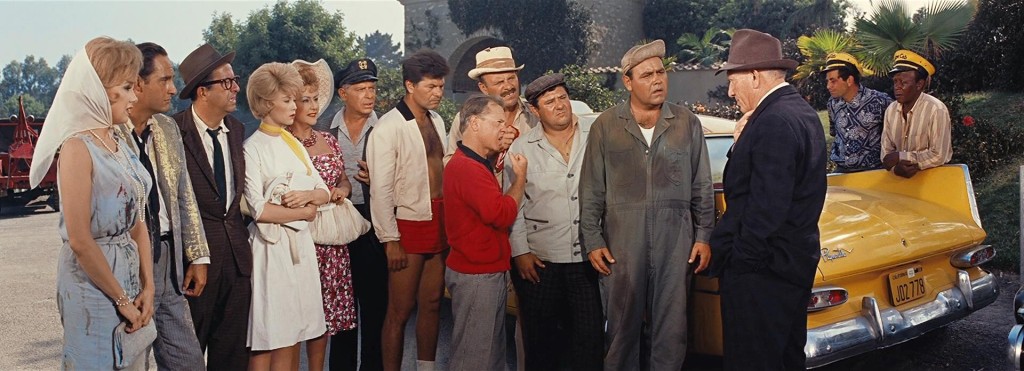 While Young Frankenstein has more laughs for this viewer than any comedy yet made, It’s a Mad, Mad, Mad, Mad World is the movie that makes me the happiest. Aptly described by director Joe Dante as “comedy nirvana”, socially-committed director/producer Stanley Kramer (The Defiant Ones [1958], Inherit the Wind [1960]), British screenwriters William and Tania Rose, and virtually every funny performer alive in 1963 set out to make “the greatest comedy ever made” and gosh darn it all to heck if they dang well didn’t succeed! While I should here admit to being a sucker for these outsize, all-star revues – I’ve happily spent countless hours with subsequent imitators like The Great Race, The Loved One, and Those Magnificent Men and their Flying Machines (all 1965) – this inaugural 70 mm Cinerama, nearly 3 hour (OVER 3 hours in its original, and — in 2014 — recently reassembled, full-length cut) comedy epic is a gigantic banana peel threatening to topple and collapse the entire weight of film history. Held miraculously on-course by indispensable screen anchor Spencer Tracy, as beleaguered Santa Rosita police captain T.G. Culpepper, the relentless search for $350,000 in stolen tuna fish factory money “buried under a Big W!” barely pauses for breath between mind-boggling car chases, wild airplane rides, and even dynamiting an entire hardware store basement before the likes of Jerry Lewis! Jack Benny! The Three Stooges! (Etc!) flash across the screen in cameo blazes of comic glory. More than a mere movie, It’s a MadX4 World is the culmination of 60+ years of vaudeville, radio, screen slapstick, nightclubs, and television. From Jimmy Durante to Sid Caesar, Joe E. Brown to Don Knotts, ZaSu Pitts to Selma Diamond, this maddest of all Worlds IS show business.
While Young Frankenstein has more laughs for this viewer than any comedy yet made, It’s a Mad, Mad, Mad, Mad World is the movie that makes me the happiest. Aptly described by director Joe Dante as “comedy nirvana”, socially-committed director/producer Stanley Kramer (The Defiant Ones [1958], Inherit the Wind [1960]), British screenwriters William and Tania Rose, and virtually every funny performer alive in 1963 set out to make “the greatest comedy ever made” and gosh darn it all to heck if they dang well didn’t succeed! While I should here admit to being a sucker for these outsize, all-star revues – I’ve happily spent countless hours with subsequent imitators like The Great Race, The Loved One, and Those Magnificent Men and their Flying Machines (all 1965) – this inaugural 70 mm Cinerama, nearly 3 hour (OVER 3 hours in its original, and — in 2014 — recently reassembled, full-length cut) comedy epic is a gigantic banana peel threatening to topple and collapse the entire weight of film history. Held miraculously on-course by indispensable screen anchor Spencer Tracy, as beleaguered Santa Rosita police captain T.G. Culpepper, the relentless search for $350,000 in stolen tuna fish factory money “buried under a Big W!” barely pauses for breath between mind-boggling car chases, wild airplane rides, and even dynamiting an entire hardware store basement before the likes of Jerry Lewis! Jack Benny! The Three Stooges! (Etc!) flash across the screen in cameo blazes of comic glory. More than a mere movie, It’s a MadX4 World is the culmination of 60+ years of vaudeville, radio, screen slapstick, nightclubs, and television. From Jimmy Durante to Sid Caesar, Joe E. Brown to Don Knotts, ZaSu Pitts to Selma Diamond, this maddest of all Worlds IS show business.
2. Sherlock Jr.
(1924, Metro Pictures Corporation, dir. Buster Keaton)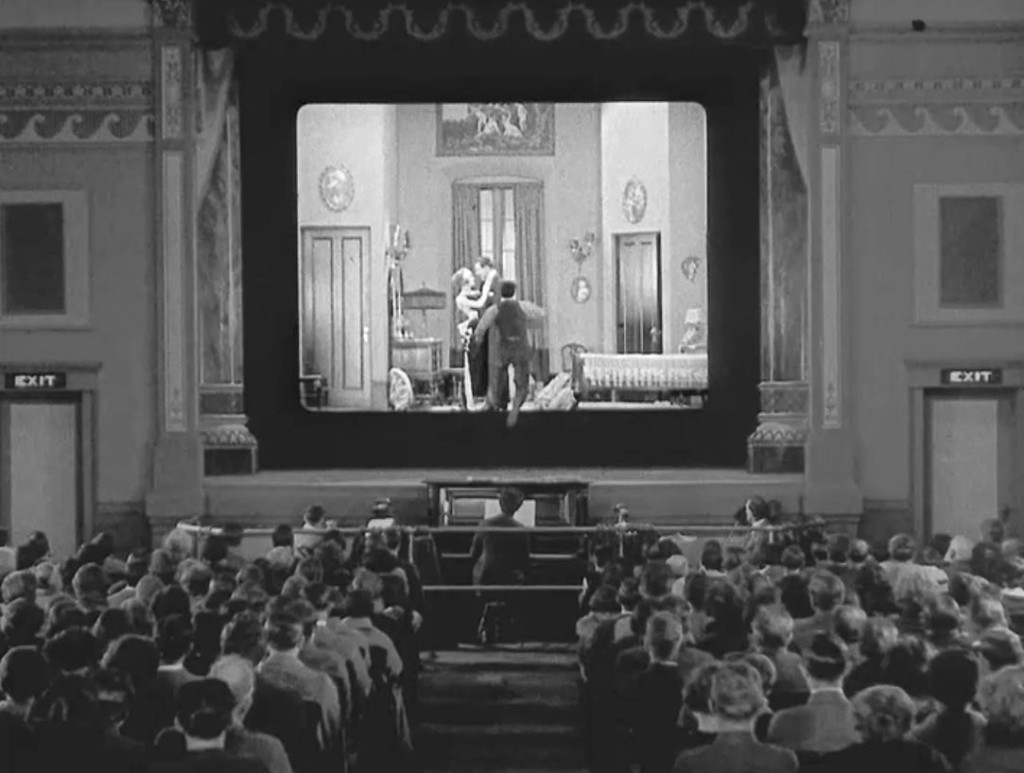
Just as these latter selections have been with me the longest, so should I also note that my top-listed favorites have been comedies; and so should I further note that of all these great comedies, my next choice has been with me longer than any movie appearing on this list: Buster Keaton’s 1924 comic masterpiece, Sherlock Jr. My hometown of Madison, WI had a very vibrant film culture in the late 60s and early 70s and one such outgrowth of this local interest in film – which includes the internationally-recognized Center for Film and Theater Research in our State Historical Society – were the numerous film societies which showcased then-obscure and long-neglected Hollywood classics. “Duck Soup Cinema” and “Sounds of Silents” were among the last remaining movie groups on the UW-Madison campus when I was a little kid (it’s actually still going strong today!), and it was to one of these “grand old entertainments!” in Madison’s “historic Capitol Theatre!” which my grandparents took me a few days after my fourth birthday. The movie? Why, Buster Keaton in Sherlock Jr., of course. Well, I need not mention that my just-four-year-old self was overwhelmed, delighted, and – indeed – marked for life by the on-screen antics of the expressionless-though-highly-expressive physical dynamo who I witnessed that day run along the top of a train, ride the handlebars of a driver-less motorcycle, and – in one of the most technically and metaphorically innovative “stunts” in movie history – leap through the silver screen into the world of film itself. Coming full circle, I took my young nephews to Duck Soup Cinema’s showing of Buster Keaton’s equally invigorating Seven Chances (1925) last fall and I can only hope they were as equally “marked” by the screen-immortal Buster!
1. My Life as a Dog
(1985, AB Svensk Filmindustri, dir. Lasse Hallstrom)
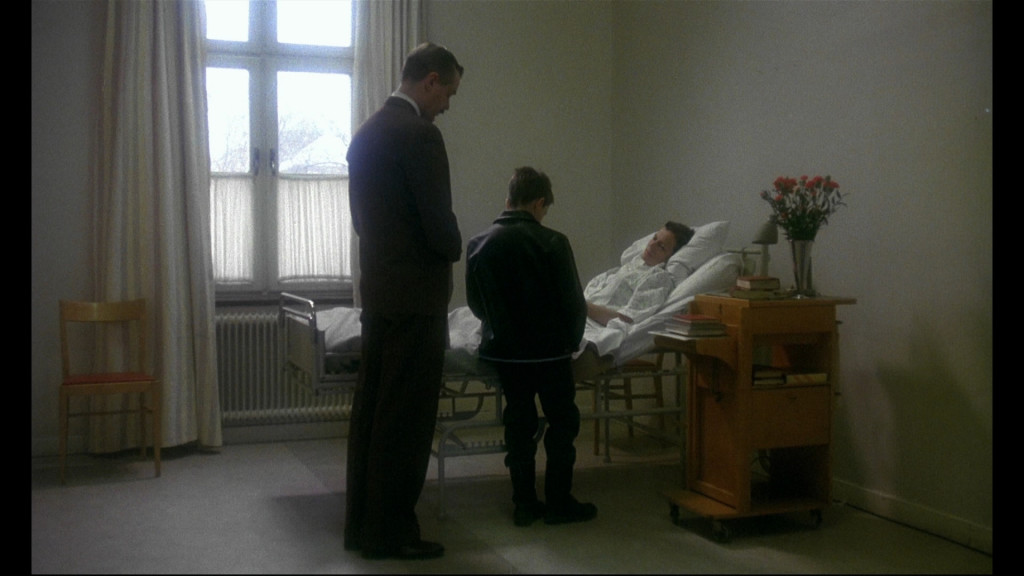 Ironically, though these latter five choices are very personal to my interest in movies – evoking the kid-like wonder that made me, for better or worse, a true cine-maladist – my final selection was a film I avoided for years, and is in fact the last movie I have seen, on a movie-watching timeline, among all these “top ten favorite films of all time”. Perhaps it was being pre-aware of the subject matter, but when I finally did hunker down to watch My Life as a Dog, a decade after my mother passed away, I felt after viewing as if some very deep part of myself had been expressed on my home-viewing screen, and that, frankly, I would never again see a film as personally resonant. Though the time, setting, country, and circumstances of troublesome young Ingemar (Anton Glanzelius) – sent off to live with relatives in the country so that his terminally-ill mother (Anki Linden) can die in peace – was far removed from my own, the emotional content described in this Sweden-set, 1950s coming-of-age tale exactly coincided with my own emotional reaction(s) in 1990s Middle America. And, wrapping back around to our discussion of cine-malady in the introduction, I think it’s that quality of immediacy and, by natural extension, empathy which ultimately sets apart film as an art form and gives what actor James Stewart once called “these pieces of time” their unique and distinctive power. For me, then – with My Life as a Dog – director Lasse Hallstrom’s “slice of life” style, in the best sense of that overused term, makes the small Swedish village of Smaland feel like home to me, and further reminds me of what it was like to be a 12-year-old boy staring uncomprehendingly into the far reaches of the night sky.
Ironically, though these latter five choices are very personal to my interest in movies – evoking the kid-like wonder that made me, for better or worse, a true cine-maladist – my final selection was a film I avoided for years, and is in fact the last movie I have seen, on a movie-watching timeline, among all these “top ten favorite films of all time”. Perhaps it was being pre-aware of the subject matter, but when I finally did hunker down to watch My Life as a Dog, a decade after my mother passed away, I felt after viewing as if some very deep part of myself had been expressed on my home-viewing screen, and that, frankly, I would never again see a film as personally resonant. Though the time, setting, country, and circumstances of troublesome young Ingemar (Anton Glanzelius) – sent off to live with relatives in the country so that his terminally-ill mother (Anki Linden) can die in peace – was far removed from my own, the emotional content described in this Sweden-set, 1950s coming-of-age tale exactly coincided with my own emotional reaction(s) in 1990s Middle America. And, wrapping back around to our discussion of cine-malady in the introduction, I think it’s that quality of immediacy and, by natural extension, empathy which ultimately sets apart film as an art form and gives what actor James Stewart once called “these pieces of time” their unique and distinctive power. For me, then – with My Life as a Dog – director Lasse Hallstrom’s “slice of life” style, in the best sense of that overused term, makes the small Swedish village of Smaland feel like home to me, and further reminds me of what it was like to be a 12-year-old boy staring uncomprehendingly into the far reaches of the night sky.
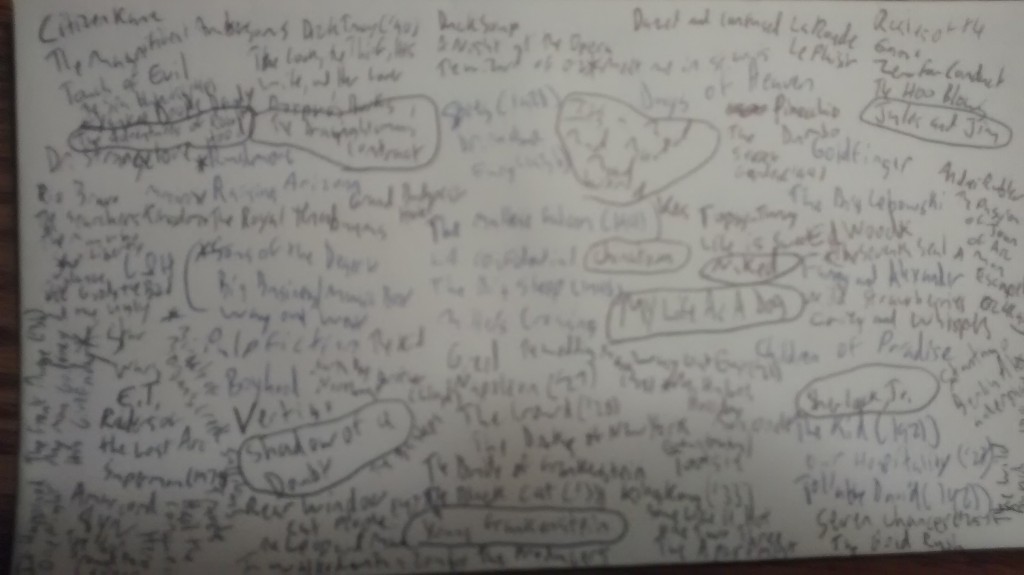 My free associative-approach to “winnowing” from an initial list of hundreds…
My free associative-approach to “winnowing” from an initial list of hundreds…
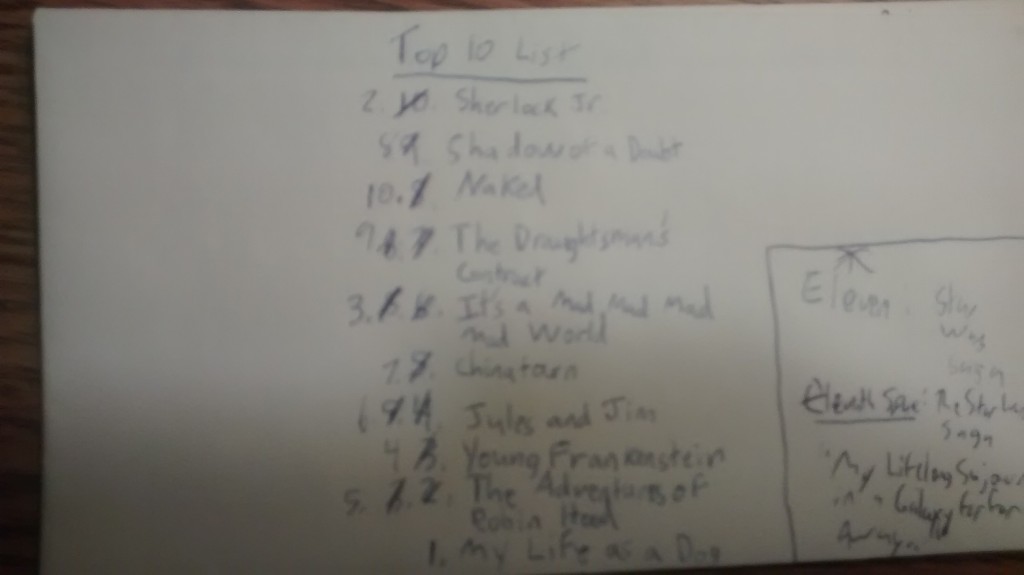 …and, even then, the “ordering” was quite the ordeal.
…and, even then, the “ordering” was quite the ordeal.


